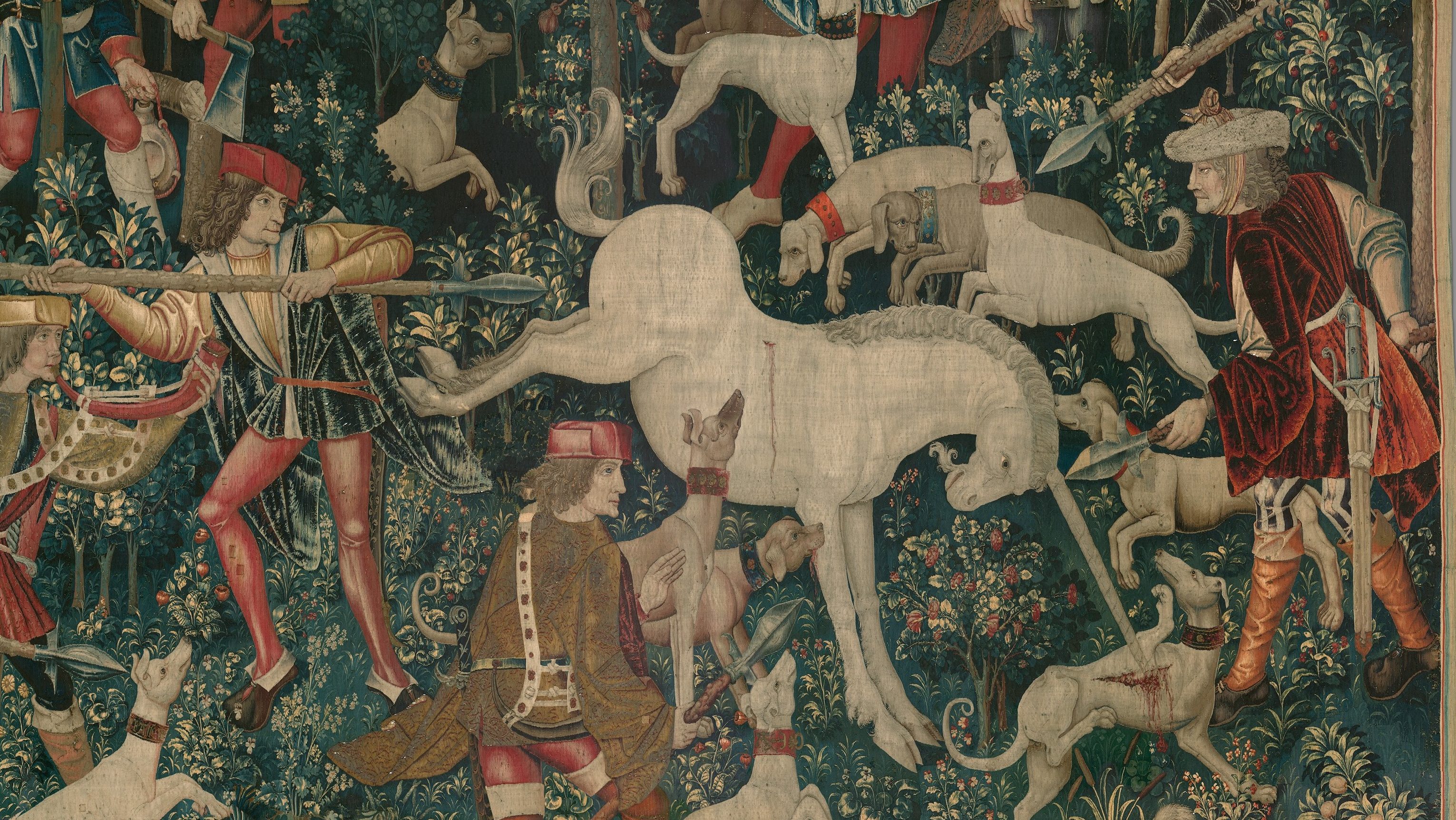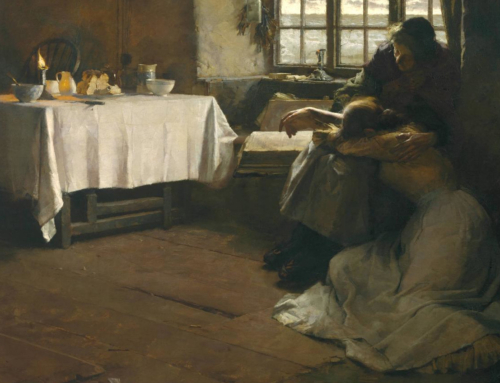If you take the news and put it in theaters, you can make big money—or at least this seems to be the thinking behind many blockbusters in recent years. Themes of terrorism and insurgency have become common, for example, and they are often portrayed in film with much of the violence that accompanies them in reality. Yet there is something fundamentally false about this. It goes without saying that Hollywood violence is supposed to be entirely fabricated. Indeed, the rare slip-ups become part of directors’ commentaries or lawsuits, generating headlines either way—Harrison Ford’s injury while filming The Force Awakens is a recent example. This fake violence can nevertheless be extremely gruesome, so much so that some people will decide to avoid purported entertainment precisely because of its graphic content.
There is a real tension here between entertainment and bloodshed. Why are we comfortable being entertained by practically the same images that we sympathetically mourn in the news? The Second Vatican Council took up this question, concluding that
the narration, description or portrayal of moral evil, even through the media of social communication, can indeed serve to bring about a deeper knowledge and study of humanity and, with the aid of appropriately heightened dramatic effects, can reveal and glorify the grand dimensions of truth and goodness. Nevertheless, such presentations ought always to be subject to moral restraint, lest they work to the harm rather than the benefit of souls, particularly when there is question of treating matters which deserve reverent handling or which, given the baneful effect of original sin in men, could quite readily arouse base desires in them. (Inter Mirifica, 7)
While there are various ways in which moral evil can be depicted in film, violence is one of the most powerful. The Council makes clear that investigating evil in this way is permissible, but how precisely does a movie “serve to bring about a deeper knowledge and study of humanity” by portraying violence? To function properly, film intended as entertainment must be rooted in two core principles: the true purpose of recreation and the fundamental way in which storytelling works. Then, a movie—or, really, any medium of entertainment—which seeks to address the darker aspects of life can approach the question of the portrayal of violence.
This is not only a question of morality but also of art. When violence crosses a certain threshold, the blood we see onscreen turns into mere colored water on a set, and any seriously-intended effect is lost. Violence is particularly difficult to handle well because it bears on the struggle between good and evil in the depths of the human heart. Our inner self is both very close to us and yet often very unclear to us, so any attempt to penetrate there can easily fall into unreality. Art that falls to excess in its portrayal of violence violates the reality of the human heart and indeed of all of creation, thereby losing its power to speak. Ceasing to be an entertaining story, it instead becomes a sadistic glorification of evil.
Recreation
In our ever more distracted age, recreation is becoming harder to find. Instead, we often settle for mere distraction, whether just one more level of a video game, checking Facebook or email yet again, or even working while watching a movie—so-called multitasking. True recreation, paradoxically, requires effort. We need the strength of will to put aside both work and distractions to truly rest in mind and body.
Saint Thomas Aquinas, the timeless Dominican theologian, illustrates this with a story. Someone came to visit Saint John the Evangelist and his disciples, only to discover that they were not praying or studying but engaging in an archery contest—mere play! When the visitor voiced his surprise at this, Saint John asked one of his disciples to shoot an arrow a couple times. He then asked whether this could be done indefinitely, to which the archer answered that it could not, for eventually the bow would break. By analogy, Saint John concludes, so would the mind break if it were never allowed to rest—and, clearly, also the body, although we can see this even without a story.
However, rest is not achieved in inactivity. If you have ever been cooped up for several days while sick, you know that after our need for sleep has been met, sitting still or lying in bed is no longer restful. Even in heaven, our hopeful state of final rest, we shall be joyfully engaged in an eternal exploration of the boundless activity of God.
Instead, rest comes from achieving the proper balance in action. We know from experience that desk work needs to be balanced with exercise, and similarly after a day of hard manual labor resting with a good book is greatly satisfying. Balance is necessary even within the bodily and mental realms. A body in which only the arms or legs are exercised is unbalanced, and likewise, while we respect focus, someone who is literally single-minded is difficult to be around.
True recreation allows us to find rest precisely by providing a balanced use of mind and body. Different people recreate in different ways, of course. Sports are a common and excellent form of bodily recreation, but simply taking a walk can serve just as well. For the mind, it is often helpful to relax by reading a well-written story, whether fiction or non-fiction. Many games, both physical and digital, keep one’s mind active by presenting puzzles or decisions that differ significantly from the day-to-day stress of schedules and time management.
A well-constructed film can also be a good form of mental recreation. As we watch a movie, we are invited to enter into a world that springs from another’s imagination, and accepting this invitation requires a certain amount of mental work. This is a learned process, but once we have attained it we can often slide into a story without conscious effort. We then lose ourselves in the activity of keeping track of the film’s hints about the world it inhabits, the actions and motivations of various characters, and the progression of the plot. Eventually, we are able to turn our attention back to the world in which we live and see it in a new light.
All of this is precisely the kind of unusual mental work that can provide us a recreational balance. This can be done poorly, however. Most clearly, content which incites us to sin is not recreational—sin is never balanced. Artistic failures, which range from tacky special effects to poor acting, can break the immersive effect of a movie and thrust us back into daily life, ending the attempt at recreation. When done well, however, film can offer us the experience of briefly entering someone else’s world. We then return to our own lives truly rested and perhaps with a renewed perspective on reality.
Storytelling
A good movie must be a good story, but telling a story well cannot be done without thinking. J.R.R. Tolkien was a master both of telling stories and of thinking about them. His essay, “On Fairy Stories,” provides a deeply insightful analysis of storytelling. His argument centers around the process of subcreating a secondary world, the world in which the story takes place (he uses the language of “subcreation” to reserve creation to God). While this is most strongly applicable to the genre of fantasy, no work of fiction really takes place within our own world, by the simple fact that fictional stories have not actually happened.
Tolkien argues that the process of subcreating a secondary world takes place by borrowing concepts from the primary world and recombining them in unexpected and interesting ways. For example, a fictional world might have a green sun. Now, we have never seen a green sun, and yet we can easily picture one when asked or recognize one when shown it. How does this work? We’re able to take the concept of “green,” which we have learned perhaps from grass or a lime, and combine it with the concept of “sun,” producing a green sun. Depending on the demands of the story, this can be done to greater or lesser degree, producing both centaurs and an angry queen—regardless of centaurs’ not existing or whether we have actually met an angry queen in our primary world.
The fact that the very language of stories is derived from the real world is precisely why we are able to comprehend and believe them, in the sense proper to story. This closeness to reality extends beyond language. We also expect stories, even the most fantastic ones, to conform to the deepest aspects of reality as we know it. While the color of the sun is tightly connected to a whole interplay of physical laws, we are able to accept a green sun quite easily because we know that color is not really key to reality. Human nature, on the other hand, is, and so having unrealistic characters is one of the worst ways in which a story can fail.
This closeness to reality then allows storytelling to fulfill its recreational purpose. A story that remains aware of its fundamental dependence on reality is able to draw us in in such a way that our minds rest in the story. However, this rest is not passive, for the world of the story is not entirely familiar and therefore invites us to consider it carefully. A skillful story-teller is able to use this effect to introduce us to a new way of looking at the primary world. Stories can make the small great and the great small, or anything in between, drawing our attention to aspects of life that we might otherwise miss. For example, the talking animals of Narnia draw our attention both to unexpected sources of human wisdom and to the great dignity of nature, also a creature of God. This sort of investigation of reality by means of parallels in the world of story is one of the highest uses to which storytelling can be put, and it is also key to the truly recreational aspect of a story.
Violence in stories
Violence in film seems to function on three levels. On perhaps the lowest level, a kind of slapstick violence, in limited quantities, can serve a recreational purpose. In real life, all too often the good guys lose to the bad, and it is pleasurable and balanced to occasionally see the opposite. The Avengers and Hogan’s Heroes are good examples of this.
The second level is the least interesting. Here, violence simply serves the continuation of the story. It is often either brief or set aside in its own, heavily choreographed moment. Lighter war movies, such as Kelly’s Heroes, often fall into this category, although of course any given film can vary between levels. The Matrix and Star Wars often tend in this direction as well, with carefully scripted action sequences that are more dance than violence. This sort of violence invites us to admire the actors’ (or effects teams’) skill, which is not a bad thing. It can also help anchor a film in reality, for it is true that some things done in the normal way simply require force. However, this use of violence falls short of its full artistic potential.
On the third and most sophisticated level, violence becomes an intentional tool of the director. This kind of violence is often integral to the story and affects the overall tone of the film. This use of violence can expand into excessive quantities of blood and gore, excruciating scenes of torture, or even sexual violence. This latter is rightly regarded as the most offensive, for it of necessity breaks into the primary world as real-life actors portray this content on camera.
Sometimes excessive violence is used simply because controversy drives up ticket sales—Deadpool is a recent example that seemed to function in this way. Many directors, however, consider gruesome violence an essential part of their story. This is often defended on the grounds that horrific violence is a part of real life, and so omitting this violence would be “false and dishonest,” as George R.R. Martin, author of the book series on which Game of Thrones is based, explained to the New York Times.
This is not a completely satisfying justification, however. If it were, there would be no controversy, but the controversy-for-tickets mode of violence continues to be profitable. This portrayal of violence to conform to real life belongs properly to the middle level, which does not require excess. Indeed, because most people in their day-to-day life do not encounter brutal violence, taking violence to excess tends to separate us from the flow of the story. This is the moment at which blood turns into red water and severed limbs into painted plastic—an artistic failure.
Even this lack of experience does not quite explain the failure of violence in this regard, though. Our minds are capable of understanding a green sun; why can they not similarly make the jump from a paper cut to the aftermath of a grenade? This is admittedly hard to see without the light of faith, but excessive, dark violence is not one of the key principles of reality. It is absolutely the case that terrible things happen in the world. However, at its deepest level, the level to which a believable story must conform, reality is rooted in the creating love of God. In fact, story is especially bound to this truth, for just as a secondary world depends on language, so does the primary world depend on God. As we distance ourselves from Him, it becomes harder to really see the goodness of creation, but there remains some part of our nature that is awake to this truth and therefore cannot be entirely satisfied by a story soaked only in violence. We can see this most clearly in the truest story of all: the mystery of the Cross.
This does not mean, however, that violence has no role to play in a story. Christ Himself did not shirk from telling such stories as that of the Good Samaritan, which begins with blows and bloodshed. The third level can be purified of excess to allow violence its proper place in the making of stories. Just as the green sun draws attention to the vibrant beauty of common grass, violence in a story can help us to ponder one of the deepest mysteries of life: evil. Torture and rape in real life are of course horrific examples of evil, but precisely because this is so clear, we do not need to see reminders on film. Violence is more effectively used to make visual the aspects of life that would otherwise lie hidden. For example, The Mission uses physical warfare to reflect the real interior struggle that faithful life calls us to, and High Noon uses a duel to make cowardice (and courage) visible. This sort of investigation inevitably leads into the depths of the human heart, where we find the source of much of the evil that afflicts the world.
Martin recognizes this, explaining that the “true horrors of human history derive not from orcs and Dark Lords but from ourselves.” Of course, his idea only reaches halfway, for the whole point of orcs and Dark Lords is to render visible the evil within us. We know that greed and a thirst for power operate in people, including in ourselves, but in the average person these desires are limited to a rather petty extent—not the stuff of drama. However, this does not mean that a thirst for power cannot damage even the weakest and least powerful of people. An orc is a creature of story that takes precisely these notions of “weak” and “power-hungry,” generally invisible when seen together in the primary world, and makes visible their true ugliness. Martin’s own Game of Thrones fails to recognize this and instead tries to investigate human evil by amplifying violence past the point of excess.
Violence used in this way must still remain faithful to reality. At the root of our identity, we are beloved creatures of God, so no matter how much evil we perpetrate, a true story cannot end entirely in darkness. This is why pervasive violence fails as a storytelling device: in the derived language of story, excessive violence teaches that man is utterly depraved, which is not the reality. Instead, violence appropriate to the concerns of genre and audience can be used to draw our attention to our own very real defects without leading us to despair upon our return to the primary world.
Thoughtful movies ultimately want to serve both as social commentary and as recreation, and telling a story is a powerful way to fulfill both of these goals. Telling a story well requires that one properly subcreate a world for the story. Within this secondary world, our minds are recreationally stretched to view the primary world in new ways. Because reality is deeply good, violence need not be a part of any story, but an artful use of violence is possible. Violence which is kept within the bounds of reality can at least help drive a plot forward while keeping those receiving the story comfortably within its world. Provided violence stays free of ultimately unrealistic excess, it can illuminate the evil tendencies hidden within us, helping us to understand and combat them. In so doing, a story-teller’s work takes some small part in the True Story being directed by the Lord.
Author’s note: The use of films as examples does not constitute an endorsement.
✠
Image: The Unicorn Defends Itself (from The Unicorn Tapestries) [CC0 1.0]
Download a PDF of this article HERE





